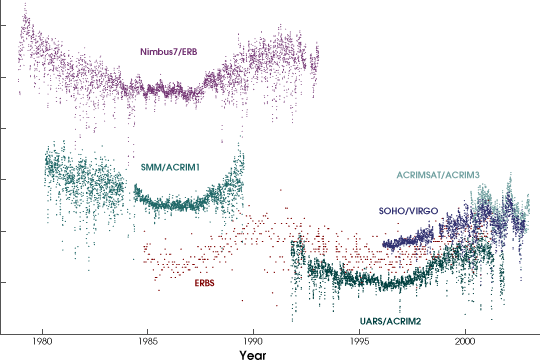| |
Is the Sun Brighter or Not? |
|
|
| |
In 1997 and again in 2003, Willson published papers in which he described the construction of a data set of satellite observations of total solar irradiance. Though mostly based on the results from the three ACRIM missions, Willson also spliced into the data set the results from two other missions: NASA’s NIMBUS 7-ERB, launched in 1978; and SOHO-VIRGO, a European Space Agency-NASA mission launched in 1995. Data from these two missions were necessary to fill in some time gaps in the ACRIM record, but it is this splicing that makes the results so controversial. |
|
  |
 |

|
| |
“The problem is that no one sensor has collected data continuously over this time period, and so to make a long-term dataset, we have to splice together the results from different instruments, each with its own accuracy and reliability issues, only some of which we are able to account for,” says solar physicist Judith Lean from the U.S. Naval Research Laboratory in Washington, D.C.
|
|
Satellite records of total solar irradiance show a far more detailed view of the solar cycle than a count of sunspots alone. This graph represents data collected by multiple instruments launched over the past 25 years. These sensors provide a way to more precisely estimate total solar irradiance, which is about 1,368 Watts per square meter. (Graph courtesy Richard Willson, Columbia University)
|
| |
Such joining of data sets can be tricky. While all six of the Sun-monitoring instruments launched between 1978 and the present show the same general trend in total solar irradiance—going up at the solar maximum and falling off during solar minimum—none of them has recorded the same absolute value. During the solar maximum of 1980, NIMBUS 7-ERB recorded the total solar irradiance as about 1,374 watts of energy per square meter, while ACRIM1 measured 1,369. At the following solar minimum, NIMBUS7-ERB recorded values around 1,371, while ACRIM1 recorded 1,367. Scientists can be confident that the general trend is for solar output to increase at solar maximum and decrease at solar minimum, but determining the absolute value at any of those times is a lot more troublesome. |
|
|
 |

|
| |
Willson says one of the strengths of his data set is that he used the original results of the satellite sensors as they were reported in scientific journals and are archived by the experiment’s original science teams. He also standardized all the measurements to match up with what he thinks is the most accurate sensor—ACRIM3. When he put all the data together this way, Willson said that the total solar irradiance had increased 0.047 percent during the 9.75 years between the minima of cycles 21 and 22. In other words, when the Sun’s output dipped down during the solar minimum in 1996, it didn’t dip as far down as it had in 1986. |
|
Unfortunately, total solar irradiance measurements made by different instruments don’t agree with one another. The magnitude of change from one moment to the next is nearly equal, but the absolute measurement of solar irradiance differs by up to 0.7 percent. This doesn’t sound like much, but the change in solar irradiance from solar maximum to solar minimum is only about 0.2 percent. The situation is even more complicated because the datasets from different instruments don’t always overlap, making comparisons difficult. (Graph courtesy Richard Willson, Columbia University) |
 |

|
| |
Not everyone agrees with how Willson put the data together. Claus Fröhlich, principal investigator for the VIRGO sensor on the SOHO mission, and Judith Lean made their own solar irradiance data set. One big difference between their approach and Willson’s is that they corrected the original results from NIMBUS 7-ERB for what they claim (in papers published in 1998 and 2002) are known sources of error caused by changes in the instrument over time. As an example, Lean points out that the first results from NIMBUS 7-ERB show some clearly anomalous behavior that couldn’t possibly be real—such as a sharp spike in recorded measurements right at the start of the mission. NIMBUS 7 didn’t have any self-checking capability of its own to help scientists correct for this unusual behavior, but when the VIRGO sensor came along, Fröhlich noticed that it behaved very much like NIMBUS 7 right after launch—also showing a spike in total solar irradiance at the start of the mission. Fröhlich and Lean corrected the NIMBUS-7 results partly based on the similarities between those two sensors and partly on additional comparisons with a third data set: NASA’s ERBS-ERBE, launched in 1984.
 Can Digging into the Details Settle this Debate? Can Digging into the Details Settle this Debate?
 Under a Variable Sun Under a Variable Sun
|
|
Integrating the conflicting satellite measurements into one consistent data set is as much art as it is science—the data sets of two research groups disagree. The data compiled by Richard Willson and Alexander Mordvinov (blue line) show an increase in solar irradiance between the past two solar minima (in 1986 and 1996), while Claus Frölich and Judith Lean’s data (red line) show no difference in solar irradiance over the same time period. (Graph courtesy Judith Lean, Naval Research Laboratory) |

